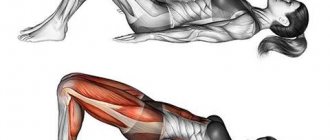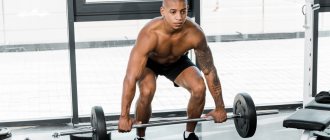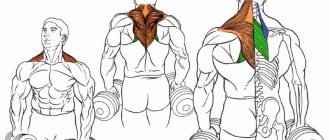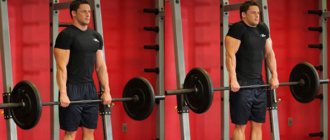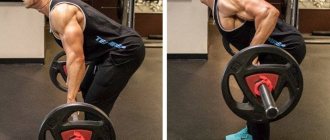The glute bridge is often compared in terms of effectiveness and biomechanics to squats and lunges - after all, these are also exercises for the buttocks.
“From the name of the exercise it is clear that the target group that receives the load is the gluteal muscles,” says fitness trainer and nutritionist Anastasia Simanova . — Additionally, the pelvic floor muscles are well worked out, this is especially useful for girls. Exercise improves blood circulation in the pelvic organs, which makes it a good prevention of diseases of the genitourinary system.”
The difference between this exercise and squats and lunges is primarily that the gluteal bridge minimizes movement in the knee joint.
“The glute bridge is an exercise where the muscles of the buttocks work in a concentric dynamic mode, i.e. contract under load,” explains Asya Alexandrova, coach of I Love Supersport, international master of sports . — It features a relatively safe position of the spine (compared to squats, deadlifts, etc.)
Rules for performing the exercise
The gluteal bridge has many variations, each of which is characterized by a specific technique. Let's consider the rules for performing the exercise depending on the type.
Classic glute bridge on the floor with emphasis on the shoulders
Sequence of actions to perform the classic version:
- Lie on the floor face up.
- Bend your knees. Place your feet shoulder-width apart and press firmly to the floor surface. Stretch your arms along your body. This is the starting position.
- As you exhale, resting your heels on the floor, lift your pelvis, tensing your buttocks. Keep your back straight so that your back and buttocks are in line.
- Having reached the maximum point, we strain the gluteal muscles and abdominal muscles. At the top point, pause for a second.
- As you inhale, slowly lower your pelvis to the starting position without relaxing at the bottom point.
The classic version can also be performed with your knees closed, bending and unbending them as you rise. In this case, the movement is performed more as static rather than dynamic, and the delay at the maximum point can last up to 8-10 seconds. The following video will help you learn more about the technique of doing a glute bridge on the floor.
We will consider other implementation options later in the material.
Errors and useful tips
In order for regular glute bridge exercises to be as effective as possible, it is recommended to organize the training process in accordance with the advice of fitness instructors.
Recommendations:
- control the rhythm of breathing (with each effort there should be an exhalation, and with muscle relaxation there should be an inhale);
- Before performing the main exercises, do a warm-up, and at the end of the workout, a cool-down (the duration of the preparatory complex should be at least 5 minutes, and the cool-down should last 3-5 minutes, maximum);
- if the gluteal bridge is performed with weights, their weight should be increased gradually, allowing the muscles to adapt to the given level of load. Otherwise, the athlete risks getting injured or sprained (during the first lesson, the weight of the weighting material, regardless of its type, should be no more than 5 kg);
- It is necessary to select additional weight so that the athlete can perform at least 10 repetitions with it within 1 approach.
The technique of performing exercises (regardless of whether they are performed with weights or not) includes not only instructions on the correct position of body parts during exercise, but also instructions on the rhythm of breathing.
Even when performing the gluteal bridge, a simple exercise at first glance, it is necessary to follow the generally accepted algorithm in order to avoid injury and achieve maximum results from the training.
Description of the exercise
Many representatives of the fair sex strive to have ideal forms. In order to correct their figure, more and more modern women are choosing fitness classes. Unfortunately, a large number of beautiful ladies cannot always find time to attend classes in the gym with a fitness instructor. However, many useful exercises can be performed at home.
To correct the shape of the buttocks, make them elastic and strengthen the muscles, a gluteal bridge is performed. It can be done by both people just starting sports training and more experienced, professional athletes. The main condition for obtaining the desired result is compliance with the execution technique.
Features of doing it at home
The exercise has some features and nuances that you should know about in advance.
- By regularly performing this exercise, you can not only achieve the desired shape of the buttocks, but also strengthen all the main muscles of the legs, as well as stabilizer muscles. At home, this is one of the basic exercises for girls and women.
- A large number of variations of the gluteal bridge allows you to choose the best option for people with different levels of physical fitness.
- Can be performed by people suffering from joint diseases. During execution, the load on them is minimized.
- To achieve deeper and more effective muscle contractions, it is recommended to use certain breathing techniques. Raising is done while exhaling, lowering while inhaling.
- Both young and energetic people and calmer age audiences can train with this movement.
- When using additional weights, the weight of the load is calculated in such a way that you can perform at least ten repetitions in each of two or three approaches without effort and tension.
- Fitness instructors recommend that the fair sex perform the element 10-15 times in 2-3 approaches. The weight of sports equipment is 0.5-1 kilograms. Young people can do the bridge 15-20 times, 2-3 approaches. The weight of sports equipment is from 1 to 10 kilograms, depending on physical fitness.
It will be possible to achieve the desired effect much faster and strengthen the muscle corset if you perform the gluteal bridge in combination with other exercises. We offer an overview of suitable ones at the end of the material.
How to include a glute bridge in your workout?
If the workout begins with complex exercises such as squats or deadlifts, then it is better to do the bridge closer to the end of the fitness lesson.
“If the feet are positioned correctly, this is an isolated exercise,” says Anastasia Simanova. “As a rule, I finish my workout with it.” This is how I finally “score” my buttocks.”
But this is not a strict rule. “You can do a glute bridge at any time during training,” says Asya Alexandrova. - It is most effective to do it in a set of squats or lunges. In general, your sports trainer will advise you when to start this exercise, since it all depends on your training plan.”
What muscles work
The main load during the execution falls on the gluteal muscles - medium and large. In addition, if you follow the execution technique, a number of other muscles are strengthened.
- both heads of the biceps femoris;
- quadriceps;
- muscles of the back of the thigh;
- core muscle fibers;
- spinal extensor group;
- calf muscles.
If you do a bridge according to the classical scheme, the load falls on the core, buttocks and hamstrings. Thanks to this, you can tighten your tummy and forget about pain in the lumbar region.
Pros and contraindications
A fit, slender, attractive body is the ultimate dream of any woman. The gluteal bridge is one of the elements that will help you achieve your cherished goal. However, beauty, slimness and fit are not all the consequences of performing the exercise. It brings much more benefits to the body.
Advantages
- High-quality training of the gluteal muscles, which eliminates excessive load on the lower spinal column.
- The abdominal muscles are strengthened and the tummy is tightened.
- Blood circulation in the pelvis improves. This is especially true for the fair sex. This exercise is used to prevent inflammatory diseases of the genitourinary system.
- You can train at any time at home, without visiting the gym.
- During training, a large amount of energy is consumed, and along with it, calories are lost. The element is recommended for weight loss and figure correction.
- The muscular system strengthens and becomes significantly stronger, which allows you to perform other types of sports activities.
- Joints are not subject to excessive stress.
- Relieves pain.
- The ability to choose the degree of difficulty by working with your own body weight, or using sports equipment as additional weights.
- This is one of the most versatile exercises in your arsenal.
Contraindications
The bridge is considered a safe element; it can be performed by people of almost any age category. The only contraindication is the acute phase of pathological processes, during which strength training and sports are prohibited.
How is the glute bridge different from other exercises?
The gluteal muscle group is the largest and most powerful group of muscle fibers in the human body. It includes three muscles. All movements in which the hip joints are involved are performed with their participation. To achieve success in many sports, great strength and fitness of this particular muscle group is required. This is important for football players, basketball players, track and field athletes, baseball players, and many other athletes.
The more trained the muscles, the more strength they have. This characteristic directly affects results and achievements in sports.
Why the glute bridge is the ideal exercise for increasing size and strength of the gluteal muscles
The glute bridge is an exercise that primarily targets the butt muscles. When performing elements such as squats and power lifts, the gluteal muscle group is auxiliary and not the main one. These elements train the back of the thigh. Therefore, it is important to do everything in a complex for deep, high-quality pumping of the gluteal muscles.
Techniques for performing the Gluteal Bridge
It is gradually necessary to complicate the exercises, and work not only with your own body weight, but also with weights and other sports equipment: barbells, dumbbells, plates, fitball, performing with one leg raised. The number of repetitions and approaches can also be increased.
Single leg glute bridge
The glute bridge, performed using one leg, allows you to more deeply work each side of the gluteal muscles in turn. The sequence of actions is close to the basic one.
- In the initial position, use not both lower limbs, but only one, as support. Leaning on your heel, extend one thigh up, as perpendicular to the floor as possible, lift your buttocks.
- Stretch out as much as possible, hold the position for 1-2 seconds if possible and return to the starting position.
This variation can be done in several ways: perform swings with a raised leg, and also complement it with twists, giving additional stress to the muscles of the anterior abdominal wall.
One leg bridge
Glute bridge on a fitball
The gluteal bridge can be performed using various types of sports equipment: on a fitball, bench, exercise machine. In the case of a fitball, which is more often used by girls at home, the following options are possible. A lighter version would be to use it to support your back.
- Lie with your back on the ball so that your hips and pelvis are suspended, almost touching the floor.
- Bend your knees. Lift your pelvis up by tensing your buttocks and thighs.
- At the top, your thighs should be parallel to the floor. Pause and return to the starting position.
Pelvic lifts lying on a fitball
In a more complicated version, the fitball is used as a support for the lower limbs.
We recommend that only trained athletes try it and do not despair if you do not complete 3 repetitions completely correctly on the first try. The thing is that due to an increase in amplitude, the load on the buttocks increases significantly. In addition, in this version, a special role is given to the stabilizing muscles of the legs, which are most often developed disproportionately worse in beginners.
- Lie on the floor with your feet on the ball so that when your legs straighten, your ankles remain on the ball.
- Lift your hips off the floor, bend your knees, and pull the ball as close to you as possible.
Transition from bridge to reverse plank
Fitness trainers successfully practice another element with the help of a fitball - the transition from a bridge to a reverse plank. The execution sequence is as follows:
- body on the floor, lower limbs bent at the knee joint, on the ball;
- raise the buttocks to the highest point;
- straighten the lower limbs by moving the fitball forward;
- stay in the reverse plank for 3-5 seconds;
- we stand in the bridge;
- we return to the starting point.
Leg bending on a fitball
Glute bridge with barbell
The exercise is designed for more experienced athletes. The barbell serves as an additional weight and exerts additional force on the stabilizing core muscles due to its long arm. The technique is as follows:
- The sports equipment is placed on the hip joint area, but not on the abdominal area. Grab the projectile from above with your hands.
- We lift the projectile along with the body.
- We remain at the top point for 3-5 seconds, then lower to the starting position.
We perform the exercise slowly, without rushing, to avoid injury.
Butt lift with barbell
Glute bridge in the leg curl machine
This type of exercise is performed exclusively in the gym. To do this, you will need a special simulator on which flexions of the lower limbs are performed. The technique differs from all others:
- Fix the mass of the weight at the desired value.
- Take the starting position so that the shoulder girdle is on the bench and the weight is in the hip joint area.
- Feet should be shoulder-width apart, hands on the bolster.
- As you exhale, strain your gluteal muscles and lift your pelvis up as much as possible.
- Smoothly lower to the starting position.
- Without touching the surface of the simulator, we repeat the exercise again.
During execution, the gluteal muscles are very clearly felt. If there are no such sensations, it is necessary to shift the weight slightly or adjust the position of the body. The video clearly demonstrates the technique
Glute bridge with rubber
This unique sports attribute can also be used to work on the buttocks for women. The sequence of actions is as follows:
- We take the starting position as with a classic bridge.
- Fix the ends of the double elastic band at the level of the pelvis on the floor surface. The elastic band is located above the hip joint.
- Each lift will be accompanied by a load of varying strength.
The load force can be set at your discretion. To do this, it is enough to loosen or, conversely, tighten the rubber more tightly.
Glute bridge on a bench
The bench in this case can perform the same dual role as the gymnastic ball earlier. It can be used to provide higher support for the back and feet. This increases the load on the buttocks and increases the range of motion. Let's consider both options for increasing the load.
In the first, as in the picture, the shoulder girdle is located on the bench. The legs are bent at the knee joint, pressing hard against the floor. The back is straight. As you exhale, we rise, and as you inhale, we lower. We don't relax our muscles. You can use additional equipment in the form of a barbell, plate, dumbbell or kettlebell, holding them with your hands.
In the second, you need to lie on your back and place your legs bent at the knees on the bench. As you exhale, raise your butt as high as possible and hold in this position for 2-4 seconds. As we inhale, we lower ourselves.
Glute bridge in Smith
To perform this you will need a Smith machine. This exercise effectively works the gluteal muscle group, while reducing the load on the back and stabilizer muscles. The technique is distinguished by its simplicity with some apparent complexity:
- Take the starting position: shoulder girdle on the simulator, feet shoulder-width apart resting on the floor. The bar is placed on the surface of the legs and supported by the hands.
- The hip joint with the bar goes down as far as possible without touching the floor surface.
- We breathe in the air.
- We bring the body to the starting position.
- Tighten your butt muscles for 2-3 seconds.
- Let's exhale.
- Repeat as many times as necessary.
The muscles must be constantly tense, control your movement. When lifting up, you need to rest your heels on the floor as much as possible.
Glute bridge with barbell on bench
And to conclude our list, one of the most technically difficult versions of the exercise. The bar serves as an additional weight and extremely actively destabilizes the core, since it is freed from additional support by hands.
- Sit on the floor with a bench behind you and a loaded barbell on your feet.
- Roll the bar over your hips and lean back with your shoulder blades on the bench.
- Push through your heels and extend your hips vertically through the bar.
- Stretch out as much as possible, return to the starting position.
Lifting the buttocks with a barbell with back support
Recommendations
- If possible, use the help of an assistant in this exercise; it is often difficult to place the apparatus on your hips on your own;
- The feet should not move around the perimeter of the floor; it is also better not to allow walking on the heels;
- The height of the bench is selected individually; if it does not fit, you should place pancakes under the legs;
- The barbell can be grasped in two ways: Feeding by two assistants by the edges if the weight is heavy;
- Independent hip roll
Tips for beginners
Those who play sports professionally or practice classes with a fitness instructor probably know how to do a glute bridge correctly and how many times. Those who have no experience and have not previously practiced the exercises will need to know some nuances.
How many reps does a glute bridge require?
The number of repetitions depends on the selected variation. The classic version can be done two approaches 15-20 times. The use of a jump rope, gymnastic ball, or exercise equipment increases the difficulty and therefore reduces the number of repetitions. Here it is necessary to monitor the quality of execution. Quantity is secondary.
Fitness instructors recommend starting the exercise with the classic version. Over time, you can move on to the use of sports attributes and the use of exercise equipment.
Useful tips
- Start classes with a small number of repetitions of the element. Gradually increase the number of repetitions and approaches. Over time, complicate the technique.
- While performing the exercise, do not lift your feet off the floor.
- The neck should not be a support when lifting the pelvis, otherwise there is a risk of pinching the nerve endings.
- Execution should not happen automatically. Each stage must be controlled.
- Control muscle tension at the top.
- Pay special attention to execution technique. The effect and beneficial effects on the body depend on the accuracy of execution.
- Remember that the muscles at the lower muscle point are also tense, so do not suddenly relax them. This will not give the desired effect.
- Watch the position of the lower limbs and at what distance from the body. If the legs are positioned correctly, the main load falls on the gluteal muscle group; if incorrectly, the main load falls on the quadriceps.
- As you lift the hip joint, move your body weight onto your heels. This will enhance the effect of the exercise.
- A set of exercises will help you work out your muscles especially productively. Effective exercises that can be used to complement the bridge: squats, scissors, bicycle, and others.
Use the glute bridge as a static element. Raising your pelvis up, freeze at the top point for two seconds, tighten the muscles of the fifth point as much as possible. You need to stay in this state for 10-15 seconds. Then you can gradually relax and return to your original state.
How else can you load the fifth point?
To achieve results, you need to choose a set of exercises that will complement each other, enhancing the effect. The following exercises can complement the gluteal bridge
- For the gluteal muscles, you can add “scissors” and “bicycle”.
Exercise "Scissors"
- To strengthen the butt muscles, it is recommended to do lunges.
Back lunges
- Squats, “walking on the buttocks,” and swings go well with the bridge.
Swing backwards with a bent leg
- Add static exercises, such as chair exercises.
Wall chair with weights
- Pay attention to the calf muscle group. This could be a banal walk on tiptoes, an exercise with skipping ropes, or raising on toes.
Single leg calf raise
Using a fitball
The use of a fitball in itself is a kind of complication of the gluteal bridge. The fact is that in addition to the main action - raising the pelvis, you need to concentrate on the ball and maintain balance - stabilizing muscles will come . The fitball must be the right size for you (height in centimeters – 110).
The gluteal bridge on a fitball can be performed in two variations.
Option one
Technique:
- Starting position – shoulder body resting on a fitball, legs pressed tightly to the floor;
- Exhale with effort and throw the pelvis upward, fixing the top point;
- Slowly we return to our original state.
The ball acts as a bench for the previous variation, but it is much more difficult to stay on it, which involves many stabilizing muscles.
Option two
Technique:
- We lie down on a spread gymnastic mat, with our feet placed on a fitball. The distance between you and the ball should be approximately thirty centimeters;
- We exhale completely and raise the pelvis as high as possible until a straight line of the body is formed. Keep your balance;
- Slowly, rolling the ball back, we return to its original state.
As noted above, this variation can also be complicated by different types of execution. You can bring your knees together at the highest point or, upon reaching a straight line of the body, lift one leg up to better work out one of the buttocks. Or you can bend one leg at the knee and perform the actions first on one and then on the other leg.
You should perform 2-3 approaches 15 times.
How to pump up your buttocks without equipment
Bulgarian split squats with dumbbells
- 3 sets of 15-20 reps
- Body part: Quadriceps Equipment: Dumbbells
Bodyweight walking lunges
- 3 sets of 15-20 reps
- Body part: Quadriceps Equipment: Body weight
Gluteal Bridge
- 3 sets of 15-20 reps
- Body part: Buttocks Equipment: Body weight
Squats without weights
- 3 sets of 20-30 reps
- Body part: Quadriceps Equipment: Body weight
Add to Calendar * Add to My Workouts * Print Workout
* — The service is in beta testing
Do this program at home once a week. The maximum effect can be achieved by selecting a set of classes for yourself and strictly following the technique.
Alternative Exercises
